 The Summer Tree
The Summer Tree by
Guy Gavriel Kay
My rating:
2 of 5 stars
This wasn't bad, but it felt decidedly stilted. I don't particularly like the concept of people from modern times being transported into a fantasy world, it feels clunky, and had a lot to do with why I didn't get on as well with this as I thought I might. The sole exception to this is the Narnia series, which I love, but there it works successfully because they are genuinely awestruck by the travel through the wardrobe, and the characterisation and writing serve to enhance this. It feels real, even though there are talking animals, and Father Christmas.
Still, Kay does have a gift for prose. I much preferred A Song for Arbonne, which I read a year ago. The characters here feel cardboardy, not fully fleshed out, they don't struggle with the sudden change of setting or express much wonder at all, and as such this doesn't read convincingly. It is more mythical in style in the same vein as Lord of the Rings or Katherine Kerr's welsh myth based Deverry series (which I tried one volume of and literally couldn't finish it, the prose was so dull). I just didn't feel involved, none of the main characters are particularly engaging or likeable and at just under 400 pages it became a bit of a slog. The book is split into four main sections, but just as the plot builds up at the end of section 2 - the tension is dropped - as section 3 deals exclusively with Dave, the moronic Dave (human sloth) and the threads aren't picked up again until section 4. I dislike stilted flashback sections like this. Tad Williams is an author who manages to write many concurrent storylines, and still manages to keep things fresh and the story alive.
The main problem with The Summer Tree is that it just doesn't cover any new ground, the fantasy elements are lifted from existing myth and legend and the ideas from existing fantasy worlds. Characters like 'Dave' who struggle to connect with their emotions were tedious in my eyes, and the appearance of a unicorn was laughable. I guess the writing didn't hook me, maybe this is because this was written in the 80's - the few scant references (Kimberley's hair turns white and she briefly considers going 'new wave' - I laughed out loud!) - and it does feel a tad dated, but ultimately I just didn't feel drawn into the world Kay has created, it didn't feel alive for me. It's a shame as the cover by John Howe lured me in, and I've wanted to read this series for ages. I will attempt the next volume, maybe, albeit with trepidation.
View all my reviews





![Irene. [The Princess and the Goblin; The Princess and Curdie. George MacDonald.]:](https://s-media-cache-ak0.pinimg.com/564x/04/3d/77/043d77c91a6f8043d631ba4fa01be268.jpg)























